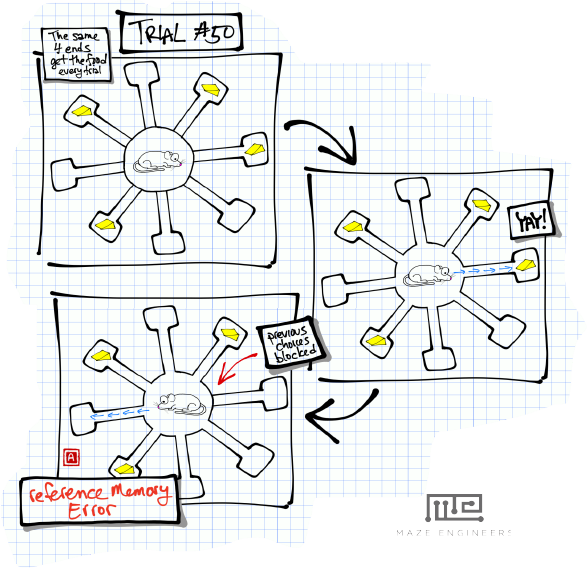Boris Podolsky: James how’s the rat business? James Moreland: Well, actually it’s mostly students I’m experimenting on now. Kurt Godel: My God, the mazes must be enormous. — IQ (the move)
Before I get caught up in all the maze knowledge I need to drop on you this week, let me welcome everyone (back) to the Blog. There’s a lot out there on the interwebs and we appreciate that you want to get your behavioral neuroscience fix here. Let us know if there are any topics you want to learn about. So, for the next few weeks our theme could be stated as: mazes, what are they good for? This is a good question because while many mazes are used to study spatial learning and memory in rodents, variations in maze design and task requirements mean that different aspects of these cognitive processes are best examined with specific mazes. In fact, we can even study different cognitive processes using a single type of maze. Enter the 8-Arm Radial Maze (whoohoo!).
Basically, a mouse sits in the center and tries to find food (or sweetened milk) by checking out the arms of the maze. After each choice, the mouse must return to the center and wait (usually, access to the arms is blocked for a few seconds). And since you asked, no, they can’t see the food, and smell is usually controlled for. What is measured? Actually, quite a few behavioral parameters can be measured, including (but not limited to):
- The number of arms they check out before finding the food
- The number of different arms they check out before finding the food
- The order they choose the arms
- The first arm they choose
- How fast they get the food
- How far they travel
- How long they pause in the center each time
- How long of a forced pause between choices affects memory
- How many trials it takes them to learn where the food is
Each parameter can tell us about different processes that contribute to the overall ability of mice to navigate the maze. For example, by keeping track of two different types of errors that mice may make, scientists can study two types of memory: reference memory and working memory. What are they? Working memory is something many people are familiar with, although it is often confused with short-term memory. Short-term memory describes holding memories for brief periods, while working memory focuses on the ability to manipulate or use the memories being held. Reference memory refers to knowledge for a certain situation that remains constant over time. Consider this task:

Figure 2. A sample task designed to test working memory. (1) All arms are baited, and the mouse waits for doors to open. (2) 1st choice: always gets the cheese. (3) 2nd choice: Mouse correctly chooses a new arm. (4) 3rd choice: Mouse re-enters an already chosen arm, committing a working-memory error, and laments his damaged hippocampus.
In this example, food is put in every arm. If the mouse chooses an arm that it has already gone down, it counts as a working-memory error. The trial ends when the mouse gets all the food. The number of working-memory errors per trial is limitless.

Figure 3. A sample task designed to test reference memory. (Top) The mouse waits for the doors to open before the 50th trial. He has already done 49 trials in which the same 4 arms were baited every time. (Middle) 1st choice: The mouse correctly goes to one of the baited arms. (Bottom) 2nd choice: Access to previously chosen arms is denied. The mouse chooses an arm that has never been baited, committing a reference-memory error. Not depicted, brief period before each choice in which all doors are closed.
In this example, food is placed in the same 4 arms every trial, and if the mouse chooses an arm without food, it counts as a reference-memory error. The trial ends when the mouse gets all the food. After each choice, access to the traveled arm is denied, ensuring that no working-memory errors occur. So, the first choice has 8 option, the next has 7, etc., and the maximum number of reference-memory errors per trial is 4.
But wait, there’s more … By manipulating task parameters, the memory load can be increased and decreased, which is important because often memory impairments are subtle, and only manifest under certain conditions. Using both types of tasks above (or some variation) is important because deficits in working memory and reference memory can be dissociated, meaning that one can occur without the other.
Lastly, by manipulating the affective states of the animals or using rodent models of diseases, researchers can use the 8-arm radial maze to study interactions between the reference/working systems and other brain networks. As some disease states are known to affect one type of memory over another (e.g. some strokes tend to affect reference memory more than working memory), rodent models of these disease states tend to use the more relevant maze tasks.
IWASAKI, T. (1997). Characteristics of radial-arm maze behavior Japanese Journal of Animal Psychology, 47 (2), 139-144 DOI: 10.2502/janip.47.139
Niewoehner B (2007). Impaired spatial working memory but spared spatial reference memory following functional loss of NMDA receptors in the dentate gyrus.
Eur J Neurosci. 25(3):837-46. Hodges H (1996). Maze procedures: the radial-arm and water maze compared.
Brain Res Cogn Brain Res. 3(3-4):167-81. Nadel L, Hardt O (2011). Update on memory systems and processes. Neuropsychopharmacology. 36(1):251-73. doi: 10.1038/npp.2010.169

